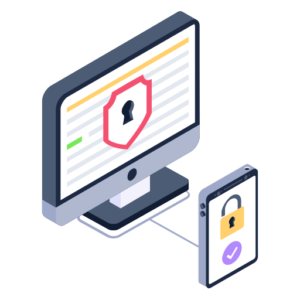A Multi-Layered Approach to Cybersecurity
A Wake-Up Call for Businesses
Statistics confirm that businesses of every size need to evaluate their current cybersecurity practices. With a 600% increase since the pandemic, the cost of cybercrime is estimated to be around 1% of global GDP. Canada is no exception! Nearly 60 percent of Canadian organizations were targeted by ransomware attacks in 2022, costing Canadian organizations $5.6 million USD.
Anti-Virus is Insufficient
In a world where cyberattacks are growing, traditional anti-virus solutions are simply not enough. Anti-virus vendors can not keep up with the development of new cybersecurity threats. The number of threats for desktop and mobile devices, social media, and cloud services is ever increasing. According to Cybersecurity Ventures, the cost of cybercrime is predicted to hit $8 trillion worldwide in 2023 and will grow to $10.5 trillion by 2025.

Start a conversation today.
Speak to one of our cybersecurity experts and request a free quote.

Endpoint Detection & Response (EDR)
Endpoint Detection and Response (EDR), also referred to as endpoint detection and threat response (EDTR), is an endpoint security solution that continuously monitors end-user devices to detect and respond to cyber threats like ransomware and malware. EDR is defined as a solution that records and stores endpoint-system-level behaviors, uses various data analytics techniques to detect suspicious system behavior, provides contextual information, blocks malicious activity, and provides remediation suggestions to restore affected systems.
Managed Detection & Response (MDR)
Managed Detection and Response (MDR) is a cybersecurity service that combines EDR technology and human expertise to perform threat hunting, monitoring, and response. The main benefit of MDR is that it helps rapidly identify and limit the impact of threats without the need for additional staffing. These experts are on call around the clock, so they can rapidly respond based on their knowledge of every aspect of endpoint security, from detection to restoring the endpoint to a known good status to preventing further compromise.


Multi-Factor Authentication (MFA)
Multi-Factor Authentication (MFA) is an authentication method that requires the user to provide two or more verification factors to gain access to a resource such as an application, online account, or a VPN. MFA is a core component of a strong identity and access management (IAM) policy. Rather than just asking for a username and password, MFA requires one or more additional verification factors, which decreases the likelihood of a successful cyber attack. MFA is based on three elements: Things you know (password / PIN); Things you have (smartphone / badge); and Things you are (fingerprints, retina).
Virtual Penetration Testing
Virtual automated network penetration testing combines the knowledge, methodology, processes, and toolsets of a hacker into a single, deployable SaaS platform for organizations of all sizes. Perform a penetration test within your environment at any given time, satisfying both compliance requirements as well as meeting security best practices. This platform is based on a framework that continuously improves over time. While assessments capture a point-in-time snapshot, penetration testing can perform a live, full-scale control test (firewall restrictions, configuration changes, etc.). A penetration test can also measure the effectiveness of these controls through its exploitation techniques.


FREE
Risk Assessment
An in-depth cybersecurity assessment is a critical component of a risk management strategy, data protection efforts, and insurance compliance. More than just a checklist, It analyzes your organization’s cybersecurity controls and their ability to remediate threats.

Awareness Training for Employees
Cybersecurity awareness training educates employees to understand common types of social engineering attacks like phishing and spear phishing. This can be taken one step further by conducting phishing simulations. Training can be performed in person or online.

